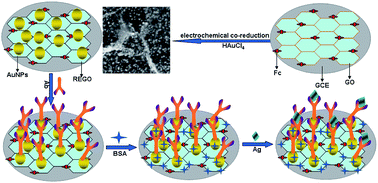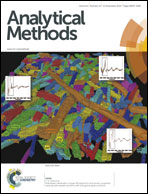Electrochemical co-reduction synthesis of Au/ferrocene–graphene nanocomposites and their application in an electrochemical immunosensor of a breast cancer biomarker
Abstract
The nanocomposites (Fc–GO) of ferrocene (Fc) hybridized graphene oxide (GO) were prepared by π–π stacking interactions. Fc–GO and Au(III) are electrochemically co-reduced to obtain Au nanoparticles (AuNPs) and Fc hybridized electrochemically reduced graphene oxide (Fc–ERGO) nanocomposites (AuNPs/Fc–ERGO). Scanning electron microscopy reveals that Au particles are about 10 nm and are dispersed uniformly on Fc–ERGO. The electrochemical behavior of AuNPs/Fc–ERGO demonstrates great electrochemical activity and stability. The AuNPs/Fc–ERGO was applied in a highly sensitive immunosensor of the biomarker carbohydrate antigen 15-3 (CA 15-3). This unique immunosensor, with AuNPs/Fc–ERGO as the immobilization platform and signal probe, exhibited significant sensitivity toward CA 15-3. Under optimal conditions, the peak current of differential pulse voltammetry (DPV) of the immunosensor decreased with increasing CA 15-3 concentration, showing two linear ranges of 2.0–25.0 U mL−1 and 0.05–2.0 U mL−1 with a low detection limit of 0.015 U mL−1. The strategy developed for this immunosensor provides a promising approach for clinical research and diagnostic applications.


 Please wait while we load your content...
Please wait while we load your content...